Two—
Subjective Spaces
The Trajectory That Landed Duchamp in America in 1915 had its origin in the provincial French bourgeoisie. His father was a Norman notary, a profession that offered considerable opportunities for enrichment in late nineteenth-century France, and the family lived comfortably while the elder Duchamp accumulated a tidy fortune. Six children survived (another died in infancy), spaced in three groups of two: the elder brothers Gaston and Raymond born in 1875 and 1876, Marcel and his sister Suzanne more than ten years later in 1887 and 1889, and two younger sisters, Yvonne and Magdeleine, in 1895 and 1898. Marcel had strong ties with his two brothers and especially with his sister Suzanne, his childhood playmate and confidante; for several years the two were the only children in the house, and the younger sisters came too late to be close companions for them.
Like other French bourgeois families, the Duchamps moved easily between seeking comfort and seeking culture. Mme Duchamp's father first made himself rich as a shipping agent before devoting himself to painting and engraving, leaving behind a body of artwork that was highly valued at home. The family read and played chess together, and music provided another activity in common. All four of the older children became artists. For Marcel and Suzanne the choice seems to have
been wholly unproblematic, with neither seriously considering any other kind of life. It is less clear whether any difficulties beset Gaston and Raymond, who embarked first on careers in law and medicine. When Gaston began to work as a painter and engraver, he changed his name to Jacques Villon, and in turning to sculpture, Raymond too assumed a new name, drawing on both the family's and his brother's to become Raymond Duchamp-Villon. The reasons for these changes remain obscure, but the fifteenth-century wandering poet, François Villon, was a hero to many in Montmartre, and paying this homage to him also seems to have been a way to resolve the felt incompatibility between the family's respectability and the sometimes immodest and risqué publications in which Gaston's early work appeared.[1] If the name changes were responses to parental unhappiness about sons who might have been doctors or lawyers becoming artists, any bad feelings were soon overcome:Marcel remembered no resistance to his choice, and the elder Duchamp gave sustained and regular support to all his artist offspring until his death in 1925, sending them money when needed, and for fairness' sake carefully subtracting each one's advances from his or her share in the inheritance.
Marcel Duchamp's entry into artistic life thus had little in common with the classic stories of rebellion and rejection exemplified by avantgarde figures like Rimbaud or Alfred Jarry. In later life he would display an unworried ability to take life as it came, his calm, unruffled self-confidence contrasting sharply with the need to prove oneself by dominating others so evident, for instance, in a figure like André Breton (whose mother decried his abandoning a medical career as a worse calamity than if he had been killed in the war). Duchamp never seemed to need the reassurance that came from belonging to a group, separating easily from his cubist friends in 1912 and keeping at a discreet distance from his admirers in dada and surrealism. In contrast to their noisy and self-conscious challenges, he seemed able to do unprecedented things with a quiet and natural equanimity, making established expectations and conventions fall away without seeming to invest much energy in the act of opposing them.
But the other side of this balance was an uninvolved, neutral quality; many who knew him would comment on his large capacity for distance
and indifference, and these attributes too appear to have been rooted in his family. Duchamp père was an expansive and warmhearted man, loved by his sons and daughters; it seems natural to associate Marcel's qualities of balance and ease with him. But the mother was cooler and more reserved, at least toward the older children. Once he was grown, Duchamp did not speak affectionately about her, and he may have felt neglected as a boy, especially after the third pair of children arrived. Robert Lebel, who interviewed Duchamp at length for the admiring study he published in 1959, wrote: "Of his mother Duchamp today remembers above all her placidity, even her indifference, which seems rather to have hurt him, until it became a goal for him in turn to attain."[2] We cannot say what sort of inner history lurks behind this rather offhand account of emotional pain and delayed identification: how did Duchamp feel the hurt? how did he respond to it? by what path did he arrive at the solution of making his mother's indifference part of his own character? We shall see that his sexual behavior as an adult led some who knew him to suspect he may have experienced some deeper psychic injury as a child, leaving him emotionally "deadened." The puzzle of his feelings would be one component of the aura of mystery that later came to surround him.
Whether intentionally or not, Duchamp provided graphic testimony to the differences between his parents, in the one portrait of each that survives. The picture of his father (Fig. 4), done in a style that suggests the influence of Cézanne (as Duchamp later acknowledged), shows him comfortably seated in a chair, attired like the respectable bourgeois he was, but free of the stiffness sometimes found in middle-class life. His physical presence is large but contained, and his eyes look directly out at us, alert and interested yet with no suggestion of challenge. The French have a phrase for the way Duchamp père appears here: he is bien dans sa peau , at home inside the skin that both protects him from the world and puts him in touch with it. The portrait is at once closely observed and affectionate, conveying both the subject's personality and the artist's comfort in his presence.
Compared with the portrait of his father, the surviving image of his mother suggests a much more complex set of feelings. The picture,
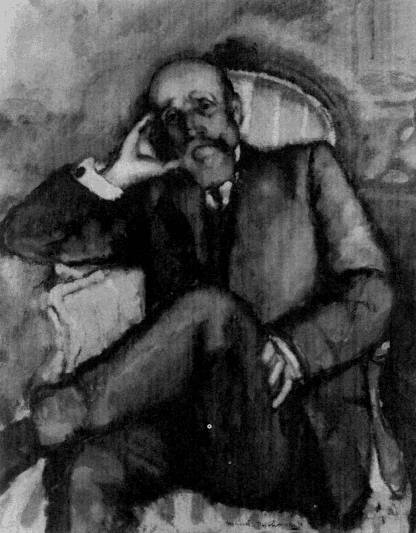
Figure 4.
Duchamp, The Artist's Father (1910)
Sonata (Fig. 5), was done a year later, in a style that has moved on from Cézanne and the fauves toward cubism, and it shows Mme Duchamp with her three daughters. Suzanne sits in the foreground, reading, while Yvonne and Magdeleine play their instruments, apparently to the mother who listens behind them; she seems to preside over a calm and harmonious family scene. But we know from more than one source that Mme Duchamp had become deaf by the time the picture was painted.[3] A deaf mother "listening" to her children's music may be displaying goodwill, but she lacks an important quality necessary to enter into their world; painting a deaf person in a musical scene cannot avoid calling attention to her separateness. One might be tempted to attribute the flat, unfocused quality of her eyes and the angular linearity of her face to cubist geometricization, were it not for the much more integrated and humane portraits of Suzanne reading and Yvonne playing the piano. Mme Duchamp here appears both within her family and distanced from it. It seems impossible to say whether Duchamp was treating her with indifference, hostility, or regret, but perhaps it was some combination of these attitudes that helped to create the irony and detachment so marked in him later on.
Duchamp's images of his parents have brought us into his early work as an artist. He began painting while a teenage student, producing local scenes and landscapes, along with portraits of family members and friends. In 1904, having finished the lycée in the Norman capital, Rouen, he joined his brothers in Paris, living with Gaston (Jacques Villon) in Montmartre and enrolling in a well-known art school, the Académie Julian, for a year. But he gave little attention to being a student and lived an idle life that he later called bohemian (a description to which we shall return); most of his artistic energies were invested in drawings and cartoons for satirical papers. From the start, he showed a natural penchant for broad, sometimes ribald humor that fit well with the spirit of sheets like Le Rire and Le Courrier français , and his later devotion to puns was already evident: one drawing-called "Woman Cab-Driver" showed an empty taxi parked in front of a hotel, implying that the driver had taken her client inside; another, "Dimanches" ("Sundays"), made a sexual joke out of what seemed to be a quiet weekend scene of a man pushing a baby carriage alongside his visibly
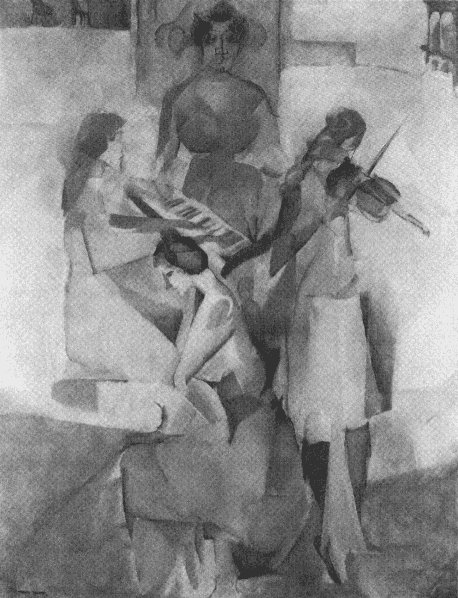
Figure 5.
Duchamp, Sonata (1911)
pregnant wife, by playing on the slang connotation of "manches" (literally handles or sleeves) as erections; appeals to "horns" and "tails" marked other work of this period.[4]
Few Duchamp paintings survive from the time between 1905 and 1910, but in that year he suddenly began a period of more intense work, which lasted until the summer of 1912. During these two years he passed rapidly from one style to another, as the two images of his parents show, successively trying out techniques observed from Cézanne, Matisse, the fauves, and the cubists. The quickness of this movement between styles has often been noticed, but it has helped to obscure some thematic continuities that link together much of this early work. One recurring motif was the opposition between the human connectedness promised by the portrait of his father and the contrasting condition of separation depicted in Sonata .
That picture's ironic revelation of detachment and isolation beneath the appearance of people present to each other also makes an appearance in a family scene from the previous year, The Chess Game (Fig. 6). Shown at the Salon d'Automne in 1910, the picture gained Duchamp the right—which he never exercised—to exhibit there in future without submitting his work to the jury. Years later he described the picture blandly by saying, "In front of my two brothers playing chess you see my two sisters-in-law having tea," and despite the stylistic differences, this moment of family life has an air of calm resembling Sonata . But the chess picture is no more a scene of simple harmony than is the musical one.
To start with, in neither of them does any person look directly at any other or at us; no face-to-face human communication takes place. In Sonata the separation seems especially marked between Mme Duchamp and Suzanne, each relegated to a separate plane and engaged in no common pursuit. Presumably the two musician sisters meet somewhere within the music they share; but it is not clear whether Yvonne looks up from the keyboard to seek out her sister or simply to stare into space, and Duchamp underlines the ambiguity by turning Magdeleine away from her partner, a situation that the diamond-shaped quadrilateral of the composition offered an easy opportunity to reverse. A similar
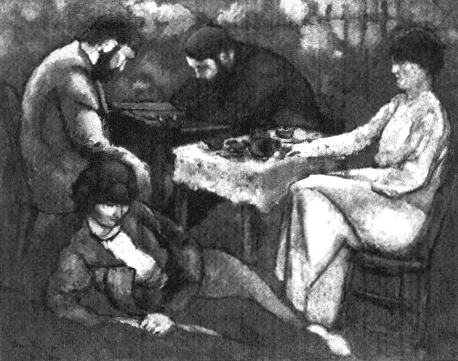
Figure 6.
Duchamp, The Chess Game (1910)
mix of relations appears in The Chess Game , where the two women at tea both seem absorbed in some inner contemplation, present at the same scene but absent to each other. By contrast, we assume that the two brothers share the mental world of the chessboard at which they both stare intently; but chess is a game where play often depends on each opponent seeing the situation in a way closed to the other, and Duchamp would later value chess precisely for the opportunity it provided to withdraw from ordinary social life. It attracted him above all because it had "no social purpose," and because those who became involved in it lived in a cloudy, blinkered world of their own.[5] Of course we cannot know that he was already responding to chess in this way in 1910, but evidence suggests that at least some elements of his later views were present to him then.
In 1911 he did a series of studies and sketches for another picture of
his brothers playing chess, and the first of these (Fig. 7) shows how distance resides inside the close connection between chess players. The two brothers stare directly toward each others' eyes, but their line of sight is broken by the opaque forms of chess pieces, and solid lines drawn into rectangles enclose each one in a separate frame. In the completed Portrait of Chess Players (Fig. 8), the separation between the brothers is emphasized by the strikingly different formal languages—both nominally cubist—in which each is represented: the figure on the right as an assemblage of curvilinear, tubelike forms that create a rounded image of considerable depth, the one on the left by flat, intersecting patches of geometricized, mostly two-dimensional surface. The chess pieces between their heads create a field over which each competes to gain some kind of power from within (in some of the other preparatory sketches the pieces appear inside the heads of the players). Later, in the Large Glass, Duchamp would employ a more developed contrast between images of different dimensionality, to indicate the impossibility of physical communication between the bride and the bachelors.
Although the moment when he would "abandon" art for chess was still years in the future, it seems that Duchamp already saw links between the two activities. His brothers who modeled as chess players were also his models as artists, and The Chess Game carefully develops the parallel between chess pieces, whose potential relations are made actual by the combinations players discover for them and the elements an artist manipulates by arranging them in a pictorial composition. The picture calls up a number of different possible relations between the people in it. Each of the male-female couples seems joined but in different ways: the pair on the left quite closely, by the vertical line of their heads and the curvilinear flow that runs down the front of the man's body and along the upturned side of the woman's; the couple on the right more loosely, by the horizontal line of their heads and the way their bodies correspond to the pair across from them. But the scene suggests diagonal connections too, between the two light-colored figures at the extremes of the picture space (their eyes on the same level) and the more dark-hued ones, whose volume occupies the upper and lower parts of the canvas's center (his line of vision potentially
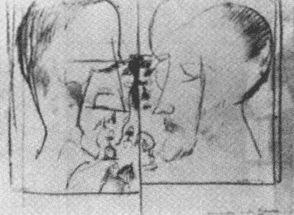
Figure 7.
Duchamp, study for Portrait of Chess Players (1911)
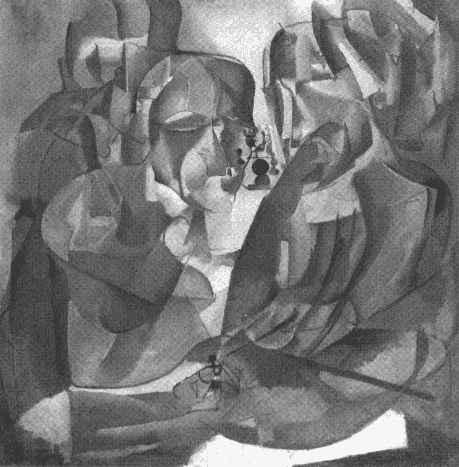
Figure 8.
Duchamp, Portrait of Chess Players (1911)
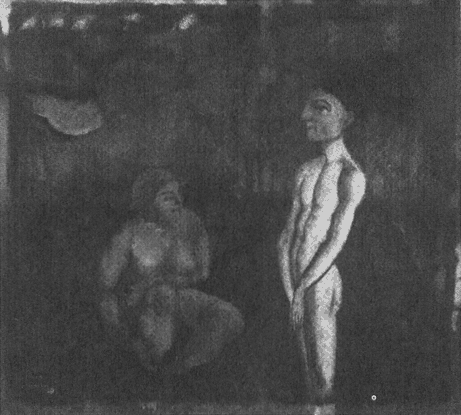
Figure 9.
Duchamp, Paradise (1910)
extending through the chess board to her). These possible recombinations are at once emphasized and undercut by the common absorption of the men in the competition of the game and of the women in their more passive states of reverie: what will the winners prize be? Like the chess player, the artist can envision possibilities other than those apparent on the surface, but none of them would establish the kind of stable communication and harmony that Sonata appears to depict before we become aware of its ironic undercurrents.
These same issues of human connectedness and detachment appear in early pictures that move outside the sphere of Duchamp's family life. One of these bore the title Paradise , and showed two figures, one male and one female, who stand and sit in a grassy, wooded setting (Fig. 9). The male figure's gesture of hiding his sex tells us what mo-
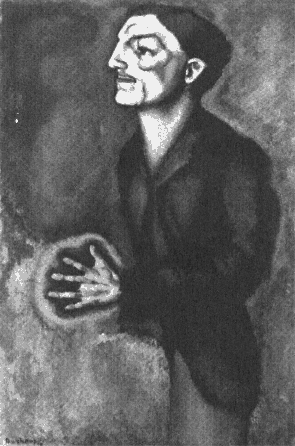
Figure 10.
Duchamp, Portrait of Dr. Dumouchel (1910)
ment we have happened upon: the one that follows on the loss of the couple's original innocence. The mien of the two figures confirms this; their unmeeting eyes and blank, anxious faces suggesting disillusionment and separation. The model for the male figure was a friend, Dr. Dumouchel. Duchamp had done a portrait of Dumouchel a year earlier (Fig. 10), in which commentators have properly seen an early example of Duchamp's fascination for the mysterious powers of modern science, both in the puzzling illumination around the upper part of the body and in the strange glow that seems at once to emanate from the hand and penetrate it, suggesting both a spiritual aura and a kind of x-ray.[6] More relevant to Paradise is the contrast between the alert, expectant quality of Dumouchel's face in the portrait and the very different mood he conveys in the garden scene. The poignancy and power
of the latter picture reside in the contrast between its Edenic title and the other state of being into which its subjects have already been exiled: although still physically within the garden, mentally they inhabit the desert of expulsion. The primal human harmony with nature and bodily existence that Adam and Eve enjoyed before the fall has been broken, throwing male and female into separate worlds of anxiety and regret. Paradise calls up the same contrast between possible connectedness and actual separation present in both Sonata and The Chess Game , now taken out of the family circle and generalized by reference to the Biblical story.
We view a seemingly less disillusioned evocation of a primal garden of delights in a picture done a few months later, Young Man and Girl in Spring (Plate 2). Unlike the figures in Paradise , this couple experience no need to hide their sexual parts, which they exhibit with a childlike mixture of innocent clarity and chaste vagueness. Their common activity may be some dance (if the season is spring it is unlikely they can be gathering fruit); whatever it is, it seems to draw attention away from their sexuality. In contrast to the heavy materiality of the figures in Paradise , the couple here are light and graceful; the vague and filmy atmosphere evokes the sort of inner poetic landscape, nuanced, musical, allusive, and incapable of direct statement, that Duchamp admired in the aesthetic of Stéphane Mallarmé the great symbolist poet, while the globe in the center and the figures in and just below it seem to locate the scene in the mythological world of constructed and protected symbols.
Everything combines to suggest that the moment depicted here is one before the loss of innocence dramatized in Paradise has taken place. But the young people's ability to remain in this state seems tied to the circumstance that, in contrast to all the figures encountered in Duchamp's other early pictures, they have no faces, as if to say that only those who possess no recognizable identity can inhabit such a paradise of harmony and hopefulness. We shall see later how important the project of maintaining personal fluidity and avoiding fixity would become in Duchamp's claim to have achieved a special kind of freedom; here unrecognizability appears as the quality that gives entry to the realm of
springlike accord from which the inhabitants of much of his other early work seem to be excluded.
In 1913, some two years after he painted Paradise and Young Man and Girl in Spring , Duchamp set down a meditation that provides strong support for the readings of these pictures just offered, and through them for the existence in his mind of the themes we have tried to identify in the family scenes. He included the text in the third of the collections of notes for the Large Glass, the White Box (also called À l'infinitif ), published in 1966, so that it also serves to tie this early work to his major project, helping to make clear what it was about the relations between the bride and the bachelors that he found so engrossing. The note has a special place in Duchamp's writings because it is the only substantial one in all those he either published or left behind (the latter were brought out after his death by his stepson, Paul Matisse) that speaks directly and in a general way about his own feelings rather than addressing some possible or actual feature of his work.[7] The note's explicit subject, looking into shop windows, may seem far from the concerns of Duchamp's pictures, but in France before World War I there was much discussion about how modern commerce sought to harness the powers of desire and fantasy for the lowly purpose of selling goods. Merchandise displays of all types—department stores, international expositions, and the salons of individual products like automobiles—all enveloped things in search of buyers in an aura of exoticism and sexual suggestion.
The shop window, Duchamp wrote, was "proof of the existence of the outside world." The way in which this proof was established, and what he meant by it, appeared through the following set of reflections.
When one undergoes the interrogation of shop windows, one also pronounces one's own sentence. In fact, one's choice is "round trip." From the demand of shop windows, from the inevitable response to shop windows, the fixation of choice is determined [se conclut l'arrêt du choix ]. No obstinacy, ad absurdum, of hiding the coition through a glass pane with one or many objects of the shop window.
The penalty consists in cutting the pane and in gnawing at your thumbs [s'en mordre les pouces ] as soon as possession is consummated. Q.E.D.[8]
Duchamp's English translators render s'en mordre les pouces as "feeling regret," but the affect dramatized by the action is more painful than that. The sentence pronounced on oneself in the first sentence is the "round trip" of the second: drawn outward into the world of desired objects by seeing them displayed, we will be sent back into ourselves once the possibility opened up by desire and choice has narrowed to fixation on certain ones. Until that moment desiring carries us outward toward a still-imagined state, promising an expanded and altered form of existence; but once satisfaction occurs, we have only the particular things chosen, and we return, frustrated and chagrined, to the previous boundaries of the self. It is this state of disappointment that provides the proof of the outside world referred to at the start: Q.E.D.
In this text the passage between hopeful desire and disappointed possession that window-gazing calls up in Duchamp's mind takes the place of the contrast between anticipation and disillusionment evoked by Young Man and Girl in Spring and Paradise . But the note casts a darker light on the difference between the two states, because it makes chagrin and regret the proof that we live in a world external to ourselves; these somber affects arise not from something specific to sexuality or from any correctable defect in the way we choose objects, but from the necessity for finding the means of satisfaction in the world outside the self. To experience the external world in this way is to know that what may promise to be sources of sustenance or pleasure within it are traps; survival and growth require radical strategies for avoiding these dangers.
The note also suggests where Duchamp's preoccupation with human communication and separateness would lead him. His window-gazer communicates in fantasy with the objects behind the pane: that is what the "coition" named in the text is about. This kind of communication is satisfying while the kind that comes with actual physical contact is not, because only the first allows the self to set the terms of its relations
with objects; this is the possibility open to the two figures in Young Man and Girl in Spring , and forever closed to those in Paradise . One who holds such a view of human relations is unlikely to seek the direct contact with others and the world suggested in Duchamp père 's portrait, but will find reason to identify with the state of noncommunication that seems puzzling and perhaps uncomfortable in Sonata and The Chess Game . Perhaps this movement from experiencing personal distance as a source of discomfort to discovering a kind of freedom in it is one thing Duchamp had in mind when he told Robert Lebel about being first pained by his mother's indifference, before adopting that quality as a goal of his own.
Duchamp's early pictures offer a few more clues to what may have made these issues important to him and how he would develop them; some of the dues have to do with sex. Although sexuality seems unrelated to the barriers that divide human beings in Sonata and is only subtly implied in The Chess Game , the place of sex is clear in the two pictures of paradise and loss. Did Duchamp feel that sex was responsible for some expulsion from a personal Eden where the external world was not a source of disillusionment? The available evidence doesn't allow for a definite answer to this question, but it provides some interesting material for speculation, letting us at least explore a few possibilities.
One of these is that Duchamp's lost paradise was the childhood time before Yvonne (and soon Magdeleine) usurped his mother's attention in his eighth year, testifying to her continuing sexual activity and widening her distance from him. Hostility to his younger sisters seems evident in two pictures of them. One, Apropos of Little Sister (Fig. 11), shows Magdeleine sitting in a pose that has usually been taken to represent her reading or working. But Alice Marquis suggests that the object on which Magdeleine sits is not a chair, but a toilet, and that probably Duchamp here shows his little sister defecating. Surprising as it may appear at first, such a reading of the picture seems confirmed by the potlike white object capped with a colored seat on which little sister's bottom rests, and it makes sense of the otherwise puzzling inscription Duchamp wrote on the back: "Une Étude de femme / Merde" ("Study of a Woman / Shit"). The result is to make the picture an
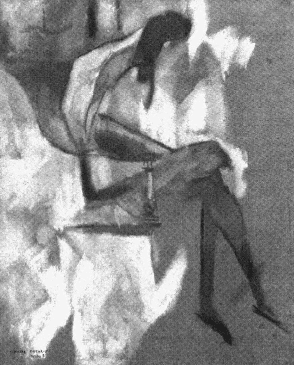
Figure 11.
Duchamp, Apropos of Little Sister (1911)
illustration of the classic Freudian complaint directed by older siblings against their younger rivals: "All he/she's good for is to make...."[9]
A different kind of hostility, this time directed toward both younger sisters, surfaces in his joint portrait of them, Yvonne and Magdeleine Torn in Tatters (Fig. 12). Certainly the picture was inspired by cubist techniques of cutting up objects and presenting them simultaneously from different points of view, as Duchamp later affirmed when he said that here "I, so to speak, tore up their profiles and placed 'them at random on the canvas."[10] But Duchamp made no similar portraits of anyone else in the period when he was experimenting with cubist methods, and the French word in the title, déchiquitées , literally means "ripped up" or "shredded." He later pointed to this picture as his first introduction of humor into his paintings; if so we need to remember that humor, notably between siblings, can often be aggressive.
A second way in which Duchamp may have felt expelled from an earlier paradise is that his own sexual awakening in adolescence somehow spoiled the innocent and free interplay he enjoyed with his favorite
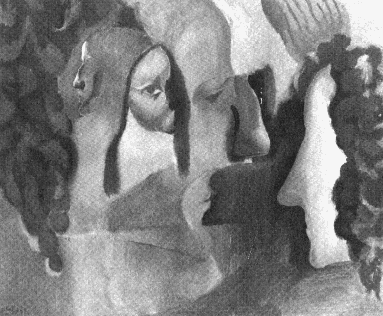
Figure 12.
Duchamp, Yvonne and Magdeleine Torn in Tatters (1911)
sister, Suzanne. Young Man and Girl in Spring was painted at the time of her wedding in 1911 and is inscribed "To You my dear Suzanne Marcel"; it may well convey a sense of how Duchamp saw their relations in childhood. The picture, and the sexuality it seems to invoke, has provoked much speculation, most boldly developed by the Italian art critic, collector, and gallery owner Arturo Schwarz. Schwarz believes that Duchamp's closeness to his sister brought them into a relationship where the possibility and fantasy of incest loomed; his relationship with her was a central experience in his life, engendering the quest for a reunion of sundered male and female principles as a central theme in his work. The same critic has argued that Duchamp sought this reunification by way of ideas and images drawn from the ancient science of alchemy, whose literature often symbolized the recovery of nature's lost, original unity as the incestual union of brother and sister. Alchemy sought to restore humanity to the powers it possessed before its fall into the material world that confines individuals and objects in separation from each other; of these powers, the famous ability to transmute base
metals into gold was only one exemplary instance. It is this mystical marriage, the ritual of humanity's return to its lost harmony and dominion, that Schwarz asks us to see in Young Man and Girl in Spring .[11]
Certainly Young Man and Girl in Spring is a kind of tribute to sexuality's undefinable power. The dedication to Suzanne seems to draw the relations between brother and sister into a scene that is suffused with sexual suggestion, childlike and innocent but erotically charged all the same. The sexual aura of the picture is heightened by the curious intersection of the hillocklike shapes on which the young people stand, causing the earth to appear in the guise of female thighs, out of whose bodily interior the background seems to rise. And, in a more aggressive double entendre, the young man's midsection is painted in a way to make us suddenly aware that the thin, dark, and slightly curved cylindrical shape that rises from his groin may not be the line of his belly, but an erect penis.
To what do these sexual allusions refer? Given the fact that Duchamp sent the picture to Suzanne at the time of her wedding, some people have read the scene as an evocation of her married future rather than the siblings' shared past. Perhaps, but the public imagination of one relationship can easily be a screen behind which hovers the fantasy of another, a possibility heightened here by the facelessness of the figures and the overall mood of ambiguity. The uncertainty Duchamp created by painting the picture in the way he did and then sending it to Suzanne is compounded by the background figures. Several commentators have tried to associate them with the future progeny of the couple, a reading that allows Schwarz to propose the figure in the globe as Mercurius, in alchemical theory the offspring of the incestuous brother-sister pair, while those who contest this see the children of Suzanne and her husband.[12] But probably the whole attempt to read these images so explicitly is misguided; within the globe there appears to be more than one figure (hence not Mercurius), perhaps combined in a kind of dance, and below it on the hillside the number of bodies resting in some way on the ground is similarly difficult to count. My guess—for that is what much commentary on such a picture must remain—is that Duchamp here included images that can be read either as other celebrants of spring or as intimations of some other place or time, un-
specifiability being one of their defining features.[13] The background serves to underline what it is about the scene that makes spring a season of poetry and hope, namely, that the outcome or result of the powerful natural forces which then begin to develop still remains in the future, free of the disillusionment that Paradise —followed by the note on shop windows—depicts as the consequence of fulfilled desire.
Little as we can know about Duchamp's real or fantasized relations with Suzanne, it seems at least possible that memories of some earlier state of unity with her had a share in bringing forth the images of separation, disillusionment, and yearning for some other state of being that recur throughout his work.[14] As for the alchemical symbolism, Schwarz is able to cite traditional images that seem to appear in Duchamp's picture, but they are too common and general to support the argument: circles, certain colors, the simple juxtaposition of male and female figures. Mystical ideas of various sorts were talked about in the groups Duchamp frequented in Montmartre before World War I, and he may have been drawn to them, but he seems to have been speaking straightforwardly when he said, in response to Schwarz's readings, "If I have ever practiced alchemy, it was in the only way it can be done now, that is to say, without knowing it." His willingness to accede even that far to Schwarz's claims needs to be set next to the comment he once made about various attempts to inject other people's preoccupations into his work: "Let the little birds do pee-pee."[15] Trying to read Duchamp's pictures in the light of alchemical traditions means turning them into sites for a kind of interpretive treasure hunt, where we continually go after hidden secrets. There is much more to be learned about him from the inside, by pursuing the themes that emerge not just from Young Man and Girl in Spring , but also from Paradise, Sonata, The Chess Game , and the note on shop windows as links between his work and his own inner life.
One thing seems undeniable: Young Man and Girl in Spring demonstrates Duchamp's impulse to clothe the meanings of his pictures in mystery. Already mystery itself was assuming a central place in his work, especially where sexuality comes on the scene, and he was finding new ways to surround himself with its aura. In 1910-11 he did two paintings, in each of which two nude women engage in some sort of
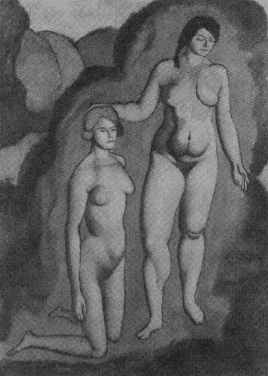
Figure 13.
Duchamp, The Bush (1910-11)
ritual-like activity with each other. One was called The Bush , the other Baptism (Figs. 13, 14). Duchamp later called attention to the first work's title, saying that it marked the beginning of a practice to which he would often recur, of attaching "nondescriptive" titles to his work. The purpose of such titles, he wrote, was to give his pictures a way to exist outside the visual experience they provided, to "introduce some anecdote without being 'anecdotal'"; the painting did not illustrate a definite theme, but the title created "the possibility to invent a theme for it, afterwards ."[16]
Titles would assume great importance in Duchamp's later work, but it is hard to see how calling the first picture The Bush could introduce any anecdote. The two women, visible within a plantlike enclosure, seem engaged in an action; perhaps the gesture of the standing figure is a way of presenting the second, who kneels beside her, to an unknown audience. The title, if anything, seems to draw attention away
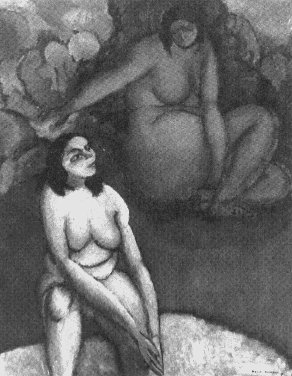
Figure 14.
Duchamp, Baptism (Two Seated Figures) (1911)
from this action, making viewers suspect that the painting's meaning—if it has one—can be known only to the artist who named it for the setting instead of the action. Giving such a name to the painting casts a veil of mystery between the artist's intention and the viewer's desire to be let in on it, placing the artist, like his subjects, inside an enclosed space of which we are unaccountably afforded a momentary cutaway view.
The uncertainties created by the second title are different. Here the action involved may well be a baptism, but how, and in what sense? Is the higher-up woman about to baptize the lower-down one? Why should she do this? Is the light-colored indentation on the edge of which the second one sits a pool of water, so that she may be about to immerse herself? These may seem overly literal questions, but it is Duchamp's titles that call them forth, giving a promise of literal meaning that stands in tension with the pictures' refusal to provide it; as viewers
we remain suspended between picture and title, our desire to enter the world where the artist seems to invite us forever unsatisfied. This use of titles contrasts with that in Paradise , where naming the scene is precisely what makes its meaning available to us; where Duchamp shared his irony with us in the earlier picture, here he begins to use it to separate his world from ours.
Duchamp created a similar mystery for his audience in a series of drawings from the same year, which he called Mediocrity, Eternal Siesta , and Once More to This Star . All three titles come from poems by Jules Laforgue, a short-lived and rebellious late symbolist poet and critic who championed the impressionists and Baudelaire in the 1890s. Laforgue's poetry was passionate and pessimistic, antic but preoccupied with death, in love with language's ability to give the world a new face but sometimes invaded by a cynical bravado: in the dialogue of "Once More to This Star" the sun exchanges insults with the earthlings it threatens to warm no longer, over which of them will appear more impotent once the old and waning star has died. Like its two counterparts, the drawing to which Duchamp gave this title (Fig. 15) bears no visible relation to the poem, unless one is expected to read the disembodied head hovering over the stairs as the sun, around which earthlings ascend and descend. Or is the figure on the right looking out a barred window addressing the sun? (The "to" in Laforgue's title was a preposition of address, not of physical movement.) We are suspended between title and image in much the same way as in The Bush , and most commentators find the drawing significant only in that its apparently unclothed moving figures anticipate the theme of Nude Descending a Staircase (a connection Duchamp several times suggested himself). Like the other images to which he attached "nondescriptive" titles, this drawing simultaneously evokes and obscures its subject, putting us in the presence of an artist whose appearance of speaking directly to us only ends up emphasizing his residence in some invisible, private space.
Choosing titles as he did offered Duchamp a new way to explore and perhaps enjoy the isolation that his other early work depicts; in these works he begins to operate as an artist within the closed-off spaces created by the very failure of communication the other pictures seem sometimes merely to describe and sometimes to lament. We can see
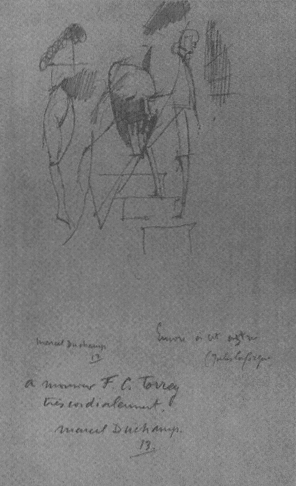
Figure 15.
Duchamp, Once More to This Star (1911)
Duchamp drawing positively on his own isolation in a different way in another picture of 1911, a portrait he called Dulcinea (Fig. 16). Its subject, as he later reported, was a woman he did not know but whom he sometimes saw walking in the Paris suburb Neuilly, near where he lived and worked at the time. The simultaneous presentation of a series of different perspectives on the same object reflects cubist practice, but by showing the woman as if walking through a series of positions, the painter has introduced the study of movement into cubism, perhaps influenced (although he later minimized the connection) by the early experiments of the Italian futurists.
But the movement depicted is not merely physical: as the woman
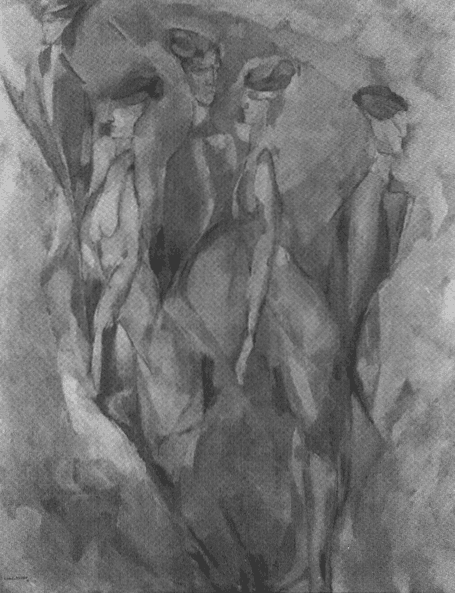
Figure 16.
Duchamp, Dulcinea (1911)
moves across the picture plane she leaves her clothed state behind and emerges nude, like a butterfly from a cocoon. Duchamp had done a number of nudes before, but the special importance of this one lies in its being the first appearance of the theme that would occupy him so much later on, that of a female form in the process of being stripped bare by a male imagination, a "bachelor." Here the stripping is performed not by anonymous unmarried men, but by Duchamp himself, his interest in the unclothed female form justified on traditional artistic grounds (perhaps also in terms of contemporary theory that saw cubist experiments with form as a search for the truth beneath appearances), but aroused also by his male curiosity about a young woman with whom he had no social connection: he later recalled that he did not know her name. In terms of the note on shop windows, Duchamp's relations with his subject in Dulcinea are still protected by the intactness of the transparent barrier that separates them; the picture records a fantasy created in his gazer's mind by the experience of proximity to a woman with whom he did not enter into any actual communication, and the persistence of idealization that results is acknowledged by naming the woman as the beloved of Don Quixote, the hero whose every interaction with the world took place under the sway of his unrestrainable imagination.
What was Duchamp like in the years he was painting these pictures? Only one account of his personality and behavior at this time seems to survive, but it describes a young man with whom the concerns we have found in his early works fit very well. It was written some years later by Gabrielle Buffet, the wife of Francis Picabia, both of whom Duchamp met in 1911.
Though very much detached from the conventions of his epoch, he had not yet found his mode of expression, and this gave him a kind of disgust with work and an ineptitude for life. Under an appearance of almost romantic timidity, he possessed an exacting dialectical mind, in love with philosophical speculations and absolute conclusions.... Duchamp enclosed himself in the solitude of his studio at Neuilly, keeping in touch with only a few friends, among whom we were numbered. Sometimes he "took a trip" to his room
and vanished for two weeks from the circle of his friends; this was a time of escape into himself, in the course of which the "sad young man on a train" [Buffet here refers to the title of a picture to which we will come shortly] was transmuted into a captivating, impressive incarnation of Lucifer....[17]
Buffet's image of a still unformed young man, mysterious and perhaps bearing a promise of menace but visibly shy and with an impulse for isolation, suggests that the interest in people confined or thrown back into their private worlds, and the impulse to exploit that situation himself, both of which recur in his early pictures, reflected features that could be observed in Duchamp's personality. The young painter who sought periodically to "escape into himself" was the same who would later be celebrated for taking art in just the contrary direction, separating it from private feeling and individual self-expression. Before we can look at the way Duchamp united these two contrary motions, we need to see how his passage between them would resonate with some widely shared features and dilemmas of modern art and culture.
The fantasy stripping of a woman observed from a distance in Dulcinea records an experience of a kind often explored by Duchamp's modernist forebears, one to which attention has recently been called by Robert Herbert in his remarkable study of French impressionism. Whereas earlier treatments of the same subject tended to focus primarily on the technical innovations of the impressionist painters, Herbert emphasizes those features of their project that mark it as a response to the conditions of modern urban life. The subjects chosen by the impressionists reflected the new public and private spaces, the transformed social relations and novel forms of leisure that emerged as Paris became a modern metropolis; within all these what the new painting often captured was the striking complex of physical closeness and psychological distance that inhabitants of great cities experience every day.[18]
Consider Manet's affecting picture of 1873, The Railroad (Fig. 17). We see a young woman next to a child, both placed against a fence through whose bars can be glimpsed a scene largely obscured by the
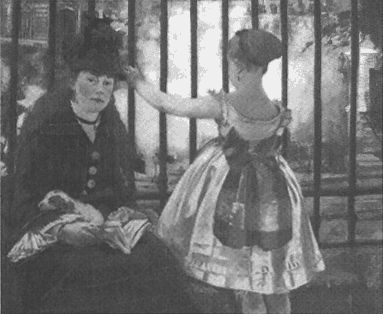
Figure 17.
Edouard Manet, The Railroad (also known as Gare Saint-Lazare ; 1873)
smoke puffed out from locomotives arriving at or leaving from the Gare Saint-Lazare; the woman faces us, while the child turns away to observe the trains. For us the viewers, as Herbert points out, "It is the encounter of one stranger with others, one of those chance meetings that mark the modern city. We do not know if the woman is the mother, the sister, or the baby-sitter of the young girl. They are merely placed side by side, and the lack of any apparent bond between them reinforces the idea that we have simply happened upon them." The young woman, her reading apparently interrupted by our passing, looks up with a neutral expression, making us "recognize ourselves as that characteristic city dweller, the unknown passer-by." Nothing regulates what we think of her, or she of us.[19]
A similar relationship is evoked by Gustave Caillebotte's The Man at the Window (Fig. 18), showing the painter's brother gazing out from a third-floor room onto a Parisian intersection. The relative emptiness and flat light of the picture free it from distracting details, so that
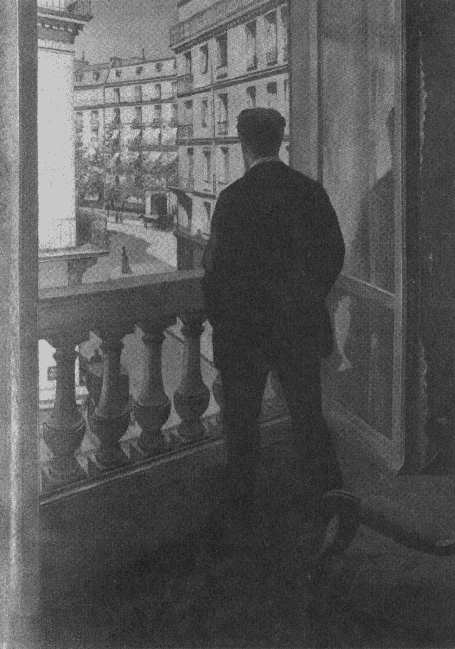
Figure 18.
Gustave Caillebotte, The Man at the Window (1876)
the woman on the sidewalk assumes a larger importance than her size might imply. The quietness of the scene emphasizes its inner, psychological import, and the woman's smallness and distance (to quote Herbert again) "make her curiously vulnerable, like some insect captured by the artist's perspective lens," giving her a quality of "fragile aloneness." We cannot rule out the possibility that the man knows the woman (or perhaps that he has seen her before from his window), but the situation pictured is one in which no direct link between them exists to rein in his thoughts about her. That the world of the modern city seems flat, objectified and anonymous, only makes it more freely available as a receptacle for the observer's imagination or fantasy. As a contemporary writer noted, "What a wonderful thing observation is, and what a fortunate man an observer is! For him boredom is a word empty of meaning; nothing dull, nothing dead to his eyes! He animates everything he sees." But because such animation depended on the observer's inner state, it was subject to the uncertain currents of the psychic interior, the vagaries of mood, and it might not cast the world in a happy light; projecting personal affect onto a rose, the observer might discover "a worm lurking in its calyx."[20]
The poet Charles Baudelaire evoked the same power of imagination, set free for modern city dwellers by the experience of noticing some particular feature of a person one did not know. The symbol of such relationships, combining visibility and distance, he found in the closed window through which he had glimpsed an unknown woman.
Out of her face, her dress and her gestures, out of practically nothing at all, I have made up this woman's story, or rather legend, and sometimes I tell it to myself and weep....
Perhaps you will say "Are you sure that your story is the real one?" But what does it matter what reality is outside myself, so long as it has helped me to live, to feel that I am and what I am?[21]
Baudelaire explicitly affirms what visual images can only imply: that what he called "our more abstract modern life" both demands and allows that individuals cut off from traditional relations feed their per-
sonal growth on the products of their subjective imaginations. They become themselves through interaction with others, but fantasy fuels their interchanges as much or more than any real contact, and what gives depth and richness to the personal worlds of individuals also makes them more separate from one another. The positive possibilities such a form of life brings are bound up with its dangers; the same modern features that encourage the imagination to soar also heighten the allure of escape into fantasy, and threaten to plunge the psyche into the abyss Baudelaire named "spleen."
Art was just as powerfully altered by these experiences as was life. Impressionism, as the originally pejorative label that gave the group its name reminds us, was among other things an attempt to capture fleeting and subjective experience. When Émile Zola sought to defend Manet and Cézanne from critical and public attacks in the 1860s, he upheld the need for innovation—as opposed to academic orthodoxy—in painting by asserting that all good art saw reality through the screen of an individual temperament. A genuine artist expanded the range of human responses by providing "a new and personal translation of nature." But Zola later came to worry that the licensing of such personal reactions would cut artists off both from their audiences and from reality outside the self. Starting from the otherwise accurate observation that the colors of objects changed with different conditions of light and atmosphere, the painter who stood for the problematic consequences of impressionism in Zola's novel The Masterpiece (L'Oeuvre) fell into the belief that "things have no fixed color," from which he ended up "overthrowing all the accepted habits of the eye and producing purple flesh-tints and tricolor skies." As a rebel against the obligation to submit his imagination to public judgment, such a person steered perilously close to losing contact with reality, convinced that originality meant substituting his private visions for the external world others perceived. A critic in the 1870s wrote similarly that he feared some of the impressionists might dive so deeply into their personal perceptions that nature would become for them "nothing but a pretext for reveries," rendering their imagination "impotent to formulate anything but personal, subjective fantasies."[22] Some of the possibilities he meant to elicit can be seen even in so attentive and closely observed a picture as Claude
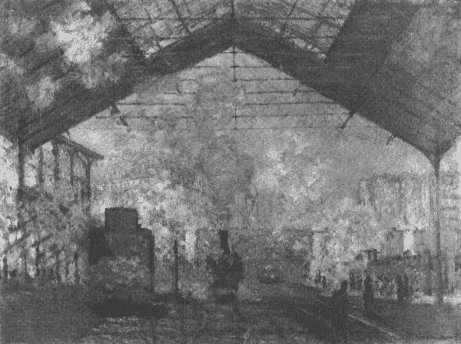
Figure 19.
Claude Monet, The Gare Saint-Lazare (1873)
Monet's interior of the Gare Saint-Lazare of 1877 (Fig. 19), where a quintessentially modern subject becomes at once a piece of direct reportage and an inner landscape of vaguely suggestive shapes and shifting, murky colors.
Impressionism thus embodied what was already becoming a defining tension of modernism, between rendering the often depersonalized experiences of modern life in a direct, neutral way and taking those experiences as a license to explore symbolic equivalents for inner mental states. We commonly associate realism or naturalism with the first of these poles and romanticism or symbolism with the second, but our vocabulary of styles and movements has no term that captures the attempt of many modernist figures to encompass both simultaneously, to put subjectivity and objectivity into a mutually nourishing relationship and cultivate their reciprocal dependence. This is what the paintings we have just considered were trying to do. Like much contemporary literature, impressionism both took on an obligation to treat
aspects of social life excluded by earlier, more academic practices and made the act of creation an occasion for exploring the inner life of the observer. Such a combination of greater openness to exterior experience and deepened insertion in the psychic depths is what gives so much power to some of the best work of Manet, Monet, or Cézanne, as well as to modernists in other genres or styles, such as Baudelaire or Picasso.
But the recognition that the interior realm could be deepened and expanded by an encounter with objects outside the self led some artists and writers to seek the fullness of subjectivity in what was most foreign to it. These more radical figures pushed the cultivation of inner experience beneath the level where reality and a particular temperament mutually nourished each other, to a point where individuality itself gave way to the impersonality of objective conditions. Here a path was opened that would lead some vanguard figures, Duchamp among them, to stretch aesthetic subjectivity to its limits, while simultaneously seeking ways to deny their own personalities any role in producing it. Some of the main points of entry to this path were mapped out in the theory and practice of literary symbolism.
Beginning with Mallarmé, symbolist aesthetics looked on the external world of objects as a storehouse of figures that could be employed to evoke inner experience, yet it often avoided the identification of this inwardness with the subjectivity of individuals. Mallarmé wrote that to create a symbol was "to evoke an object little by little, in order to show a state of mind or a mood [état d'âme ], or, conversely, to select an object and to extricate a mood from it, by means of a series of decodings." Emerging from a gradual descent into the interior of objects, the poet gave voice to "the image flying out of reveries inspired by them."[23] But it would not do for these dreamlike states of mind to be merely the private reactions of particular, limited individuals. Quite the contrary, the poet who created symbols in this sense had to undergo a discipline that transmuted his individual nature into an instrument of the universal. As he put himself through this regimen during the 1860s, Mallarmé wrote to a friend that he felt himself becoming impersonnel , "no longer the Stéphane you have known-but an aptitude which the spiritual universe possesses to see itself and develop itself, by way of that which was once me."[24]
Mallarmé's greatness as a poet makes us take seriously in him what would be narcissistic delusion in most others, but his own understanding of his art did not entrust poetic universality to individual talent. Poets possessed an instrument to free them from the limits of personal existence, namely, poetic language; in writing, the poet "cedes the initiative to the words," finding in the world that comes to life under his pen features he could not have discovered by himself, as objects, forms, and patterns take on shapes determined by purely linguistic relationships, the connections and allusions of sound, rhythm, rhyme, and verbal interplay. Such a world, mixing the familiar with the strange, has some of the mysterious allure of dreams, filled with objects we know well but whose relations to us and among themselves forever surprise us. These qualities are witness to the outside power that speaks through the mouth of the poet, transforming the world as no mere individual could.[25]
If this program sounds somewhat mysterious to us, it struck many people in Mallarmé's time the same way. His poetry and that of his followers often seemed incomprehensible to outsiders, and it is typical of the movement that it was organized around a small circle of initiates, a céacle . Regarding the truth about life as a mystery hidden behind the surface of everyday events and their language, the symbolists seldom apologized when others complained that their writing was difficult or inaccessible. They believed that one purpose of poetry was to cleanse language of the impurities that attach themselves to words in everyday usage; people accustomed to ordinary speech were bound to be puzzled by the writing that restored the link between words and a higher truth. Mallarmé sometimes resisted the idea that his language was obscure in itself, saying that he became obscure only "if people are misled and think they are opening the pages of a newspaper."[26] But he carefully cultivated the linguistic innovations that made his work impenetrable to many readers, and other participants in the movement saw the question of symbolist obscurity differently. The critic Rémy de Gourmont, for instance, while recognizing that symbolist writing aspired to a level of universal significance where it could speak to humanity in general, found the reason for its difficulty in the radical individuality of its visions. Symbols in Mallarmé's sense—images that
evoked moods or psychic states—took their rise in the interior of individual minds and were bound to be colored by the peculiar conditions that obtained in each personal interior; giving individuals the freedom to express their separate visions produced a kind of delicious chaos. "Personal art—and it is the only art—is always more or less incomprehensible."[27]
One of the best visual equivalents of this aesthetic was the work of a painter and engraver whom Duchamp admired (and who also had a great success at the Armory Show, without experiencing the skepticism and back talk that greeted Duchamp), Odilon Redon. Beginning his career in the 1860s, Redon was still active before World War I, but by then he had turned away from the mysterious, disquieting subjects of his early engravings and lithographs to produce the harmonious and sometimes sentimental flower pictures that made him a popular artist. When he was first becoming known, however, it was images like the haunting Melancholy (Fig. 20) that brought him to public attention. During the 1880s he was closely associated with symbolist poets and critics, who saw his work as a visual counterpart to contemporary literary tendencies, as he himself suggested by illustrating texts dear to them from authors like Flaubert and Edgar Allan Poe. To his literary admirers, the strangeness and mystery of Redons work testified to the intensity of his search for "new, precise and gripping means of expression" able to represent those regions where the far depths of individual experience merged with the necessity of its own dissolution.[28]
Redon accepted these interpretations of his work for many years, both by giving literary titles to his drawings and engravings and by agreeing to the readings poets and critics offered of them. Later he would do a considerable about-face, declaring that the critics who first sponsored him had distorted his work by weighing it down with their own interests and concerns: far from being inspired by philosophical or literary ideas, his images, he now said, had their birth in the anxiety he felt when faced by blank paper and the need to fill it up, and his encounter with his materials contributed much more to the anxious tone of his pictures than any outside influence. It seems impossible to say which of these accounts of what made Redons early images so puzzling and mysterious ought to be preferred—perhaps they are not
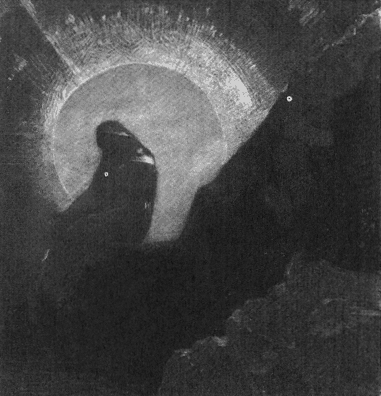
Figure 20.
Odilon Redon, Melancholy (1876)
so mutually contradictory as some critics have thought—but the coexistence of hermetic literature and personal anxiety as sources of these qualities was one feature of his work that Duchamp's would share, most evidently in his references to Jules Laforgue.
Just how alive these issues still were in the time of cubism can be seen in the attempt by Albert Gleizes and Jean Metzinger to provide a theoretical rationale for that movement's practice in their pamphlet of 1912, On Cubism . With them we reach Duchamp's own milieu, for Gleizes and Metzinger were members of the circle of artists that included all three Duchamp brothers and that often met to discuss aesthetic questions at Gaston and Raymond's house in Puteaux.[29]
Although they insisted on cubism's originality, Gleizes and Metzinger were well aware of its continuities with earlier modernist projects.
Despite its differences with impressionism, cubism too was an art of subjectivity: "As many images of the object as eyes to contemplate it, as many images of essence as minds to understand it." Every artist begins by discerning in nature some form that presents "a certain intensity of analogy with his pre-existing idea," and then "endeavors to enclose the quality of this form (the unmeasurable sum of the affinities perceived between the visible manifestation and the tendency of the mind) in a symbol likely to affect others." The plane of a picture organizes sensual stimuli and thought into a pattern that reflects an individual artistic personality: "This plane reflects the personality back upon the understanding of the spectator, and thus pictorial space is defined: a sensitive passage between two subjective spaces."[30]
For Gleizes and Metzinger this passage was not intended to be an easy one; quite the contrary, only a painting that confronted its viewers with some difficulty was able to lead the mind "little by little, toward the imaginative depths where burns the light of organization.... The picture which only surrenders itself slowly seems always to wait until we interrogate it, as though it reserved an infinity of replies to an infinity of questions." But the virtues of difficulty turned sour if it became permanent unintelligibility; only artists devoid of real creative power would be tempted to trumpet their distance from common taste and expectations by engaging in "fanciful occultism" or an "attempt to fabricate puzzles."[31]
It seems impossible to decide whether Gleizes and Metzinger had Duchamp in mind in issuing this warning; some of his early pictures were favorably cited in On Cubism , and its authors would still be his friends when they met in New York during 1915; but they were also the ones who rejected Nude Descending a Staircase a few months after the book appeared. Duchamp's attraction for turning his pictures into puzzles was already evident in The Bush and Baptism , and Apollinaire, writing at nearly the same time as Gleizes and Metzinger, noted that by giving his pictures "an extremely intellectual title" that seems to oppose their concrete content, Duchamp "goes the limit, and is not afraid of being criticized as esoteric or unintelligible."[32] Later on, many of his admirers would try to search out occult meanings in his work.
We need to remember, however, that even Gleizes and Metzinger
did not blame the temptation to make mystery a virtue in itself on individual failings only: it arose directly out of the condition that cubist artists shared with earlier modernists, the necessity of operating from within a private space of subjectivity. To abandon the attempt to effect "a sensitive passage between two subjective spaces" might therefore be a way to reveal some possibilities within modernist aesthetic practice—and by extension within the more "abstract" social relations that give rise to it—which moderates like the authors of On Cubism preferred to wish away.
For Duchamp the existence of such a passage had been problematic from the start, and his early pictures already show him beginning to explore the consequences of accepting, even celebrating, its absence. His path was leading him toward a question that Gleizes and Metzinger preferred not to confront: what would art become at the point where modernist subjectivity was pushed to its limits, stretching the bridge between artist and beholder until it broke?